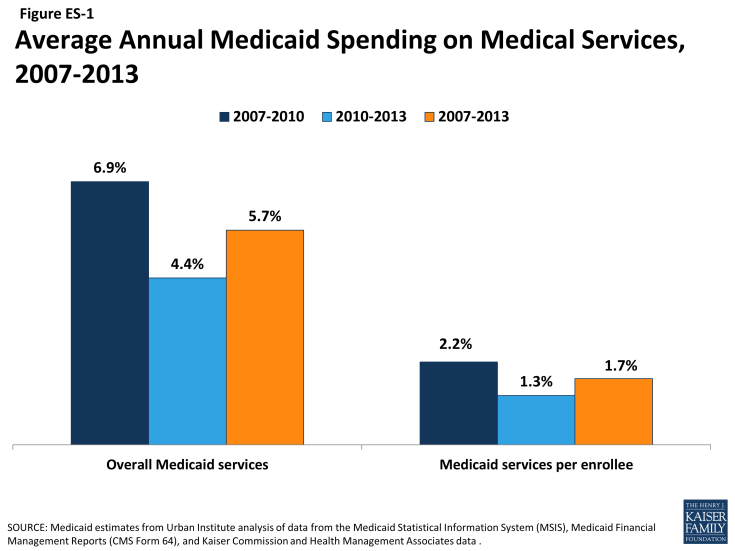Trends in Medicaid Spending Leading up to ACA Implementation
In the years leading up to the Affordable Care Act (ACA), Medicaid programs were influenced by several factors, including enrollment growth related to the Great Recession, fiscal pressures and changes in program financing, and preparation and early implementation of some ACA provisions. This paper presents data on Medicaid spending during the period of these changes, the first half of which we refer to as the “recessionary period”, and the second half of which we refer to as the “post-recessionary period”. We use administrative data to first examine overall spending trends and trends by service type. We then draw on additional data to analyze per enrollee spending growth during this period, both by service type and by eligibility group, to understand what drove Medicaid spending. Key findings include:
- Overall, spending on medical services in Medicaid increased by an average annual rate of 5.7 percent over the 2007-2013 period, with average annual spending growth higher during the recessionary period (6.9 percent from 2007-2010) and slowing during the post-recessionary period (4.4 percent from 2010-2013).
- Overall Medicaid spending is a function of both the number of people served by the program and what the program spends for each person enrolled. On a per enrollee basis, Medicaid spending growth grew by an average annual rate of just 1.7 percent between 2007 and 2013. During the recessionary period, 2007 to 2010 (when overall spending growth was nearly 7 percent), per enrollee spending grew by just 2.2 percent. Average annual growth per enrollee fell to 1.3 percent from 2010 to 2013.
- Enrollment growth among families was a major driver of Medicaid spending growth during the recession. While enrollment among families grew by 7.2 percent a year from 2007 to 2010, spending per enrollee grew by only 4.4 percent. From 2010 to 2013, enrollment growth among families slowed to 3.1 percent a year and per enrollee spending was still about 4 percent, leading overall spending growth for families to slow.
- Between 2007 and 2013, both overall and per enrollee acute care spending grew faster than long-term care spending. This difference reflects enrollment trends, since low-income families gaining Medicaid coverage during the recession are more likely to use acute care services than other types of services. It also reflects particularly slow growth in long-term care spending related to state rebalancing efforts, slow growth in enrollment among the disabled and elderly, and shifts in some long-term care services to managed care.
- Both overall and per enrollee Medicaid spending growth for prescription drugs and institutional long-term care have slowed substantially or declined from 2007 to 2013, while payments to managed care increased over this period. These patterns likely reflect policy decisions in some states to shift provision of prescription drugs or long-term services and supports into managed care contracts. They also may reflect policy choices to increase manufacturer rebates for prescription drugs and “rebalance” long-term care to less expensive community-based services.
- Compared to other benchmarks, Medicaid spending growth has been low from 2007 to 2013. Growth in per enrollee Medicaid spending on medical services was lower than that for national health expenditures per capita, the consumer price index for medical care, and per enrollee spending for private health insurance.



